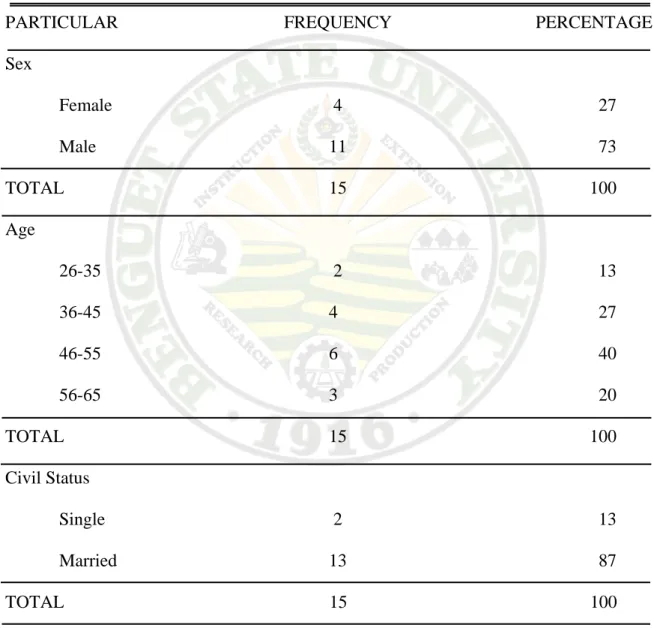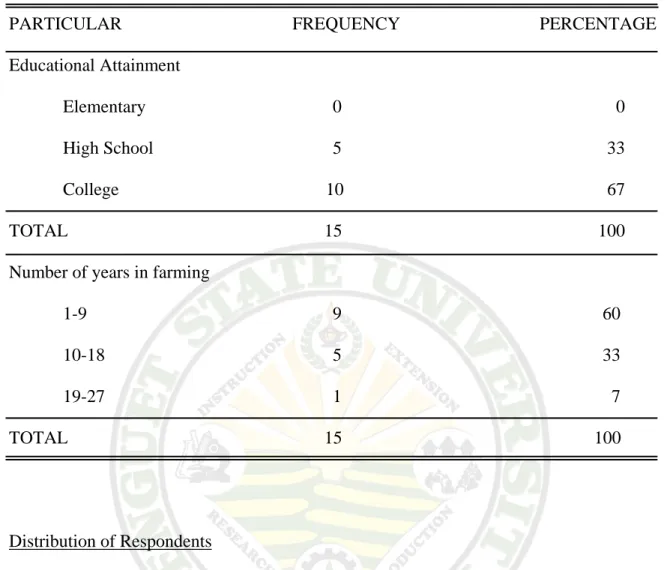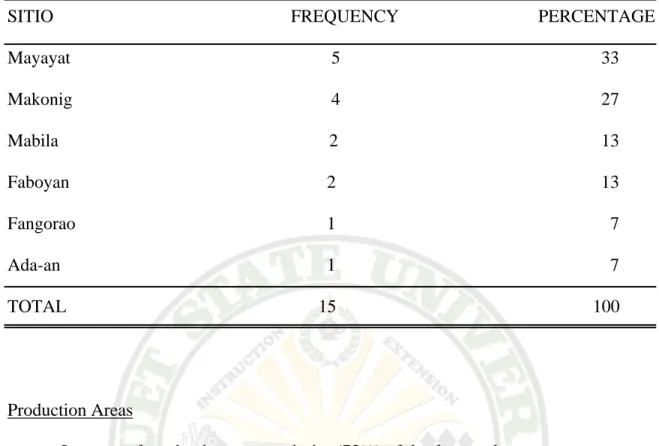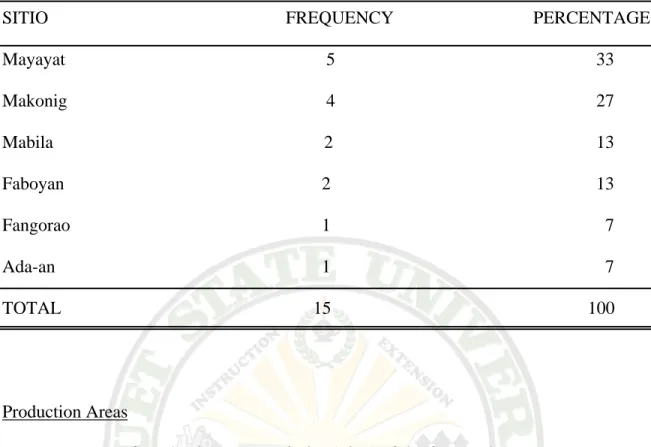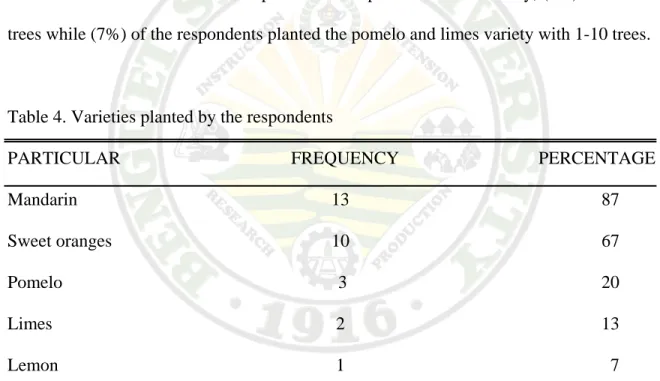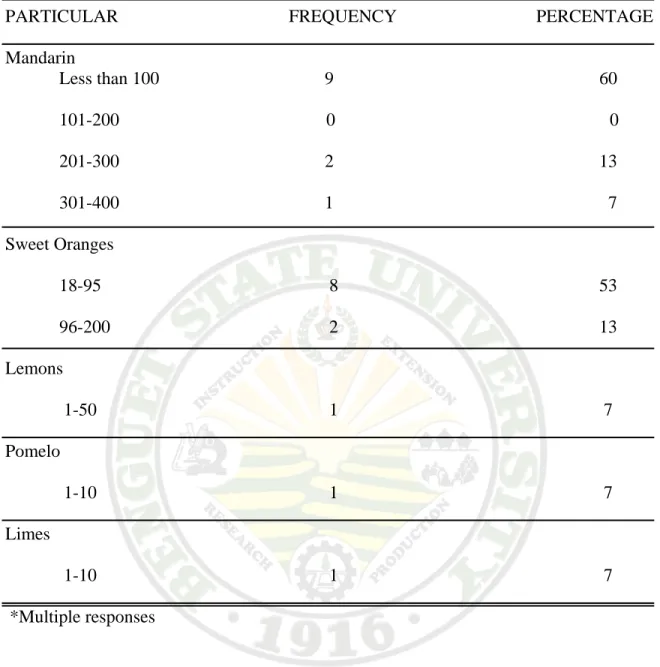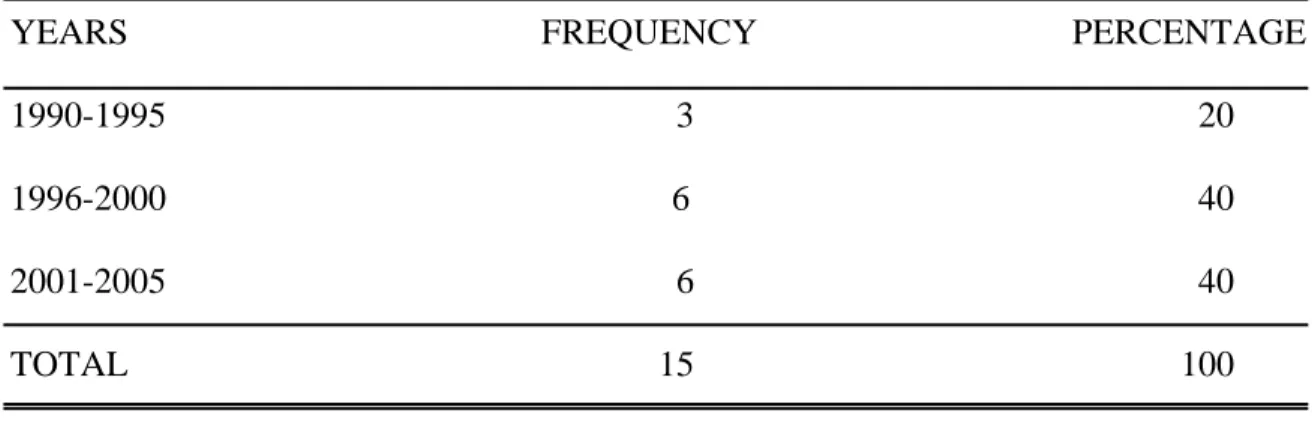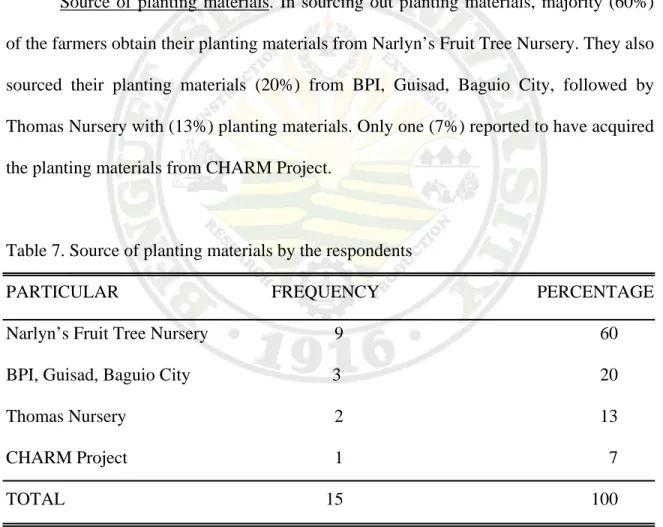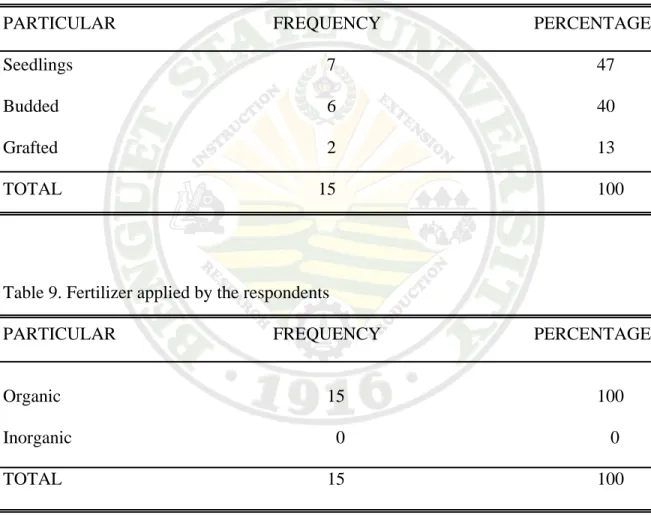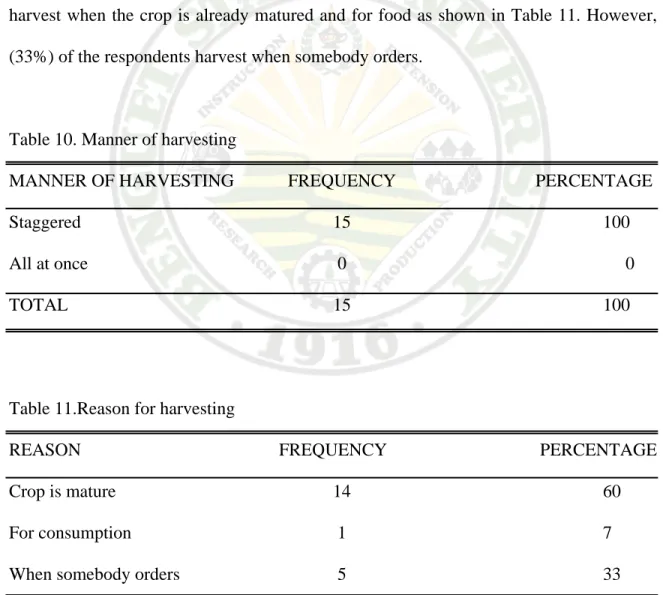CHALUYEN, SHEENA ANDREA C. APRIL 2009. Production and Marketing Practices of Citrus in Maligcong, Bontoc, Mountain Province. Benguet State University, La Trinidad Benguet.
Adviser: Luke E. Cuangey, BSc
ABSTRACT
This study was conducted in Maligcong, Bontoc, Mountain Province to describe the production practices of citrus, marketing practices of citrus and the most commonly problem that citrus growers encountered.
From the gathered data most (73%) of the respondents were males. The age group described were middle aged, this were under age bracket 46-55 with (40%) followed by 36-45 (27%). Thirteen (87%) of the respondents were married. All the respondents were literate. On the other hand, (60%) of the respondents had been farming 1-9 years.
Most (30%) of the citrus growers were from sitio Mayayat. In terms of production area, majority (73%) of the farmers had an area not more than 800 sq meters. Three (40%) with an area of 1001-2000 sq meter and one (7%) with an area of 2001-3000. On their production practices, majority (87%) of the respondents plant Mandarin followed by Sweet oranges (67%). On the other hand, the least planted citrus varieties were Pomelo (20%), Limes (13%) and Lemons (7%). Most (47%) of the respondents used the seedlings as planting materials. In sourcing out planting materials, majority (60%) of the farmers obtain their planting materials from Narlyn’s Fruit Tree Nursery. In harvesting,
ii
National Crop Research and Development Center (BNCRDC) and done by staggered basis. All (100%) of the respondents applied organic fertilizer by using sunflower and cow dung. As to marketing practices, majority (53%) of the farmers sold their products to wholesalers and retailer (47%). Most (80%) of the respondents delivered their product to the buyers and (20%) of buyers picked up the product. Most (60%) of the respondents sold their products on cash basis and credit basis (40%).
The major production problems encountered by the respondents include pest and diseases management and insufficient knowledge in producing citrus. The marketing problems encountered by the respondents were delayed payment, limited marketing outlets and lack of promotional activities.
iii
Page
Bibliography……….. i
Abstract……… i
Table of contents………... iii
INTRODUCTION……… 1
Rationale………... 3
Objectives of the Study………. 3
Significance of the Study……….. 3
Scope and Limitation……… 3
REVIEW OF LITERATURE………... 4
Citrus Varieties………. 4
Overview and Opportunities of the Citrus Production in Cordillera Region………... 5
Pre-Production Practices………... 5
Post Harvest……….. 9
Post-Production………. 9
Marketing Practices and Problems in Citrus Industry……….. 9
iv
Locale of the Study………... 11
Respondents of the Study……….. 11
Research Instrument and Data Collection………. 11
Data Analysis……… 11
RESULTS AND DISCUSSION………... 12
Respondents of the Study……….. 12
Distribution of Respondents……….. 14
Production Areas………... 15
Production Practices……….. 16
Harvesting Practices……….. 20
Marketing Practices………... 21
Problems Encountered by the Farmers………. 22
SUMMARY, CONCLUSIONS AND RECOMMENDATION………... 24
Summary………... 24
Conclusion……… 25
Recommendation……….. 25
LITERATURE CITED………. 26
APPENDIX………... 27
A. Letter to the Respondents………. 27
B. Survey Questionnaire………... 28
INTRODUCTION
Rationale
Citrus (Citrus spp.) is one of the major fruit crops grown in the Philippines. It has a good commercial potential. Citrus fruits are consumed either as fresh or juice. The peel and seed oil of some species are used as food additives for flavoring, coloring and perfume. Citrus rind is also used in the preparation of candies and marmalades (BNCRDC, 2007).
Citrus production in Mountain Province has been promising considering the climatic conditions prevailing such as tropical and sub-tropical climate which is conducive to citrus growing. Citrus can be grown in four types of climate but areas with well-distributed rainfall throughout the year are best. Those with distinct and long dry periods should bank heavily on irrigation to raise high quality citrus fruits.
Citrus growing that has become a lucrative enterprise for some farmers in Mountain Province but recently it slowed down because the growers found out that it is financially draining due to expensive chemical inputs. The inevitable problems on pests such as aphids, mites, scale insects, fruit flies, and diseases like Huanglongbing or greening and tristeza has greatly affected the production of citrus fruits. Inspite of this, the area for citrus expanded from 71,000 hectares in 2000 to 105,000 hectares in 2004 (Ochasan, 2005).
Tracing the migration and development of citrus is like having a course in world history. One of the well-known local citrus grower was the Masfere Family of Spanish
descent who came to Mountain province as a philanthropist and popularized the highlands in photography.
Existing citrus in the highlands is believed to have been introduced by the American missionaries in the 1930s. Bauko municipality in the Western Mountain Province had been called the “California of the North” because temperate fruits like citrus and apples were being grown in commercial scale. The plantation was later wiped- out by the devastating pink disease.
Today, citrus growing provides a rewarding enterprise for the fruit grower with remarkably good prices of fresh fruits in the local markets. Fresh fruit are available in the markets. This was made possible with the implementation of the RP-German Fruit Tree Project by the Bureau of Plant Industry in 1992 until the present. Various varieties of citrus had been propagated and citrus mother gardens had been established and benefited more than 3000 fruit growers either backyard and/or citrus orchards.
The many importance and potentials of citrus farming in Mountain Province prompted the Local Government Unit (LGU) of Mountain Province to develop the industry; varieties/type of citrus is widely adapted to soil and climate of the province, increasing market demand of citrus products from the province and available lands for the industry (Ochasan, 2005).
Objectives of the Study
This aimed to document the citrus production and marketing activities in Barangay Maligcong Bontoc, Mountain Province. Specifically, it aims to:
1. describe the citrus production practices;
2. describe the citrus marketing practices;
3. identify problems encountered by the farmers.
Significance of the Study
The findings of this study would hopefully contribute to the accumulation of knowledge on the production practices of citrus growers in Maligcong Bontoc. This assessment promotes understanding on the production problems of citrus growers and help to find out the possible solutions based on the grower’s recommendations. This research would serve as guide for farmers who are aspiring to be involved in citrus production. This study would be a reference for future related studies.
Scope and Limitation
This study was primarily a documentation of citrus production and marketing practices in Maligcong Bontoc, Mountain Province.
REVIEW OF LITERATURE
Citrus Varieties
Mandarins. Locally known as “sintones” and “dalanghita”.The fruits are generally smaller than oranges with fine and thin skins, which are easy to peel. Varieties include: Szinkom, Ladu, Gayunan, Ponkan, King Murcott, Kara, Satsuma and Clementine.
Sweet Oranges. Popular as a dessert fruit and for its juice. Also processed into marmalades and used for flavoring. Skin is generally thick, tough and leathery. Varieties include: Valencia, Navels, Hamlin, and Trovita (BNCRDC, 2007).
Lemons. Grown extensively for their acid juice for drinks, garnishes and flavorings. Lemons are oval with smooth skin and a marked point at the distal end.
Varieties include: Meyer, Verna, Taylor and Eureka.
Limes. It is an acid fruit with a characteristic flavor. The juice is used for refreshing drinks. Commercial products from limes are lemonade and marmalade.
Varieties include: Bears, Tahiti, Mexican and Rangpur. Calamondin or calamansi is also grown intensively in the country.
Tangelos. The flesh is fine textured and has a less bitter flavor component than grapefruit. Tangelo varieties include Minneola and Orlando.
Pomelo. Locally known as “lukban” or “suha”. They have thick skins, abundant seeds. Varieties include: Magallanes, Siamese, Chinese, Red chandler.
Overview and Opportunities of the Citrus Production in the Cordillera Region
Citrus production is a growing enterprise in the Cordillera. The area planted to citrus is about 2,056 hectares with potential expansion to about 5,534.25 hectares.
However, at present only less than half of the area planted is productive or economically viable due to various problems.
One particular advantage of citrus production in the Cordillera region is the color development of the rind to yellow or orange owing to the relatively cool climate. With this characteristic, the Cordillera grown fruit is comparable to imported ones. The challenge, however, is to make Cordillera-grown fruit competitive in terms of quality and price in the local market. In this way importation will be reduced and thus dollars are saved through import substitution (Ochasan, 2001).
Pre-Production Practices
1. Seedling Production/Propagation
Selection of seeds for rootstock. Use of seeds either imported or extracted from rootstock fruits is highly recommended by the Narlyn’s Fruit Tree Nursery to ensure sustainable citrus production.
Preparation of growing medium. Gather topsoil from the forest, compost and sand. The soil mixture is composed of 2 parts topsoil + 1 part sand +1 part compost.
Seedbox and sowing. Narlyn’s Nursery uses available wood slab for his seed box.
It is place in an elevated portion and could be carried to a shade when necessary.
2. Land preparation. Clear the land of grasses, weeds and any obstruction. Stake the site where each tree will be planted. Dig holes of about 50 x 50 cm width and 60 cm depth. Make holes bigger on compact or heavy soils. Fill the hole with compost or composted animal manure/vegetative plant parts mixed with the excavated soil.
Production
Planting. Budded planting materials are planted six months after budding at the onset of rainy season but because irrigation water is available, planting is done anytime of the year. Avoid planting during hot summer weather.
Remove the plastic bag and check roots for rotting or goosenecks. Prune severely bent roots. Plant the seedling into the prepared hole as deep ass they were standing in their original container. It is recommended to plant in mounds. Cover with top soil and press firmly. The bud union must not be covered with soil at planting. Water immediately if no rain is expected (BNCRDC, 2007).
Weeding and Mulching. Weed an area equal to or larger than the tree canopy to avoid competition for moisture and nutrients. Use dried grasses or rice straw. Mulch must be at least 5 cm thick and placed 20 cm away from the base of the tree to prevent trunk rot. Mulch prevents weed growth, improves soil structure and provides organic matter when it rots (BNCRDC, 2007).
Irrigation and Drainage. Proper irrigation during the dry season and a good drainage during wet months ensure a good quality crop and stable yield of citrus.
Fertilizer uptake and translocation in the tree largely depends on the water supply. During new flush development, flowering, fruit set and fruit enlargement, optimum soil moisture
is a must. Even slight water deficiency may mean smaller and shortened flush. A severe water deficiency leads to poor development, incomplete flowering, poor fruit set and high rate of fruit drop. It is during the late fruit development stage where citrus trees need their greatest amount of water. On the other hand, during fruit maturing stage, soil should be kept fairly dry in order to inhibit vegetative growth. After harvest, the tree needs small amount of water to restore tree growth. Water requirement of citrus is approximately 1000-2000mm annually. Irrigation maybe applied by surface, sprinkle, trickle or mist methods. Whatever method is used, the proper amount and quality of water should be considered (BNCRDC, 2007).
Fertilization application. Fertilizer recommendations are numerous and varied.
Each farmer seems to have his own special mixtures and formulations to produce the best yields and quality fruits. In practice, the application rate of fertilizers varies according to age of the trees, fruit load, soil fertility and the nutrient status of the tree. If available, soil testing and leaf analysis are good ways to monitor the nutrient status and hence will serve as a basis for fertilizer management. In this way, fertilizer application is optimized, thus production is increased and cost is reduced (BNCRDC, 2007).
Method and time of fertilizer application. Fertilizers maybe applied by circle banding (a furrow is cut, 20 cm wide and 30 cm deep around the tree in a circle beneath the outer canopy); strip (suitable for old orchards; parallel furrows are cut, 20 cm wide and 30 cm deep, between the rows of trees); and hole placement (four or five holes of about 15-20 cm in diameter and 30 cm deep are dug beneath the outer canopy of each tree).Fertilizer must be applied at the right time. It can be applied in two to three doses.
As a guide, about 50% of the fertilizer required must be applied within one month after
harvest until the emergence of flushes. The other half is applied after fruit set. If applied at the doses, the 50% fertilizer requirement may be split after fruit set and during the fruit development stage. Do not apply nitrogen during the late fruit development or maturity stage (BNCRDC, 2007).
Insect pest management. Marigold flower, hot pepper and other insect repellant plants are planted in between the orange trees to serve as repellants (HARRDEC, 2007).
Organic pesticide is also being recommended. This is prepared from the decoction of the sunflower + cow dung + hot pepper or tobacco to control powdery mildew, aphids, mites and cutworms. Aside from spraying, the use of improvised insect catcher out of plastic plates greased with motor oil (BNCRDC, 2007).
Training and pruning. In the second year after transplanting, train the tree to a single trunk with three to four well-distributed branches. Remove all sprouts below 50 cm from the ground. The citrus tree is an evergreen and needs very little pruning except to remove diseased or dead twigs, unproductive branches as well as those less expose to sunlight. Lemons, however, need pruning after harvest. For sealing pruning cuts, heat together ½ gal. asphalt and 1 ½ tbsp.coconut oil. Cool before use (BNCRDC, 2007).
Harvesting. Citrus can be harvested 5-9 months from flowering depending on the variety, environment and cultural management practices. Use pruning shears to avoid damage of the fruits. Cut the stem as close as possible to the stem end. Do not pull the fruits from the tree (BNCRDC, 2007).
Post Harvest
Sorting. Sort according to size, color and rind qualities. Discard diseased and misshapen fruits.
Packing. Fruits should be carefully packed in plastic or wooden crates. It is best to line containers with newspapers or other suitable materials to avoid abrasions on the fruit.
Degreening. Degreening is the removal of green coloration on the rind to improve the appearance of fruits. This can be done by ethylene gas application in a closed chamber.
Waxing. This is done to minimize shriveling and to impart additional gloss of fruits.
Storage. Storage duration varies with cultivars and species. Tight-skinned citrus like Valencia orange and pomelo store longer than the loose-skinned varieties. At ambient conditions, citrus can be stored only up to two weeks (BNCRDC, 2007).
Post-Production
Packaging. Sorted fruits should be carefully packed in the packaging materials such as cartoons, plastic crates and sando bags (HARRDEC, 2007).
Marketing Practices and Problems in Citrus Industry
Marketing is one of the most important factors in determining the success of any organic farming enterprise. It includes most of the decisions made by producers. These decisions range from determining the most marketable varieties to produce to deciding how to deliver high quality fruits and vegetables to consumers at a profit. However,
marketing does not begin after the fruits and vegetables are produced. Instead, marketing alternatives need to be considered even before production takes place.
Marketing is the business activities associated with the flow of goods and services from production to consumption. Marketing of agricultural products begins on the farm, with planning of production to meet specific demands and market prospects. It is complete with the sale of the fresh or processed product to consumers, or manufacturers in the case of raw materials for industry. Agricultural marketing also includes the supply to farmers of fertilizers and other inputs for production. It also directs the flow of goods and services from producer to ultimate users. One way of moving a particular commodity is through middlemen generally classified as wholesalers and retailers (Pacsi, 2008).
The wholesalers and contract buyers are the common channels of marketing. Cash payment is the most acceptable term of payment. Passenger jeepney’s and human beings are use to transport farm produce to nearest market outlet. Basket and sacks are common containers for their farm product (Pacsi, 2008).
The country’s agricultural development effort’s since 1950’s have directed towards production to attain self-sufficiency. Philippines agricultural marketing has been left to the private sector within the context of free market system. The private trading sector can be viewed as a complex system of market intermediaries who are involve in buying, transporting and processing and considered marketing mix where in the industry determines, in response to market, not only the product but also the prices, the channel of distribution, the market place and promotion and advertising, that an industry does not mean much unless its products is sold (Pacsi, 2008).
METHODOLOGY
Locale and Time of the Study
The study was conducted in Maligcong Bontoc, Mountain Province from the months of December 2008 to February 2009.
Respondents of the Study
The respondents of the study were fifteen citrus growers in Maligcong, Bontoc, Mountain Province.
Research Instrument and Data Collection
Questionnaires were distributed to the respondents and retrieved by the researcher.
Data Analysis
The data collected was analyzed using simple statistical tools such as frequency counts and percentage.
RESULTS AND DISCUSSSION
Respondents of the Study
Table 1 presents the personal profile of fifteen (15) citrus growers from Maligcong, Bontoc, Mountain Province. The profile of the respondents was described in terms of sex, age, civil status, educational attainment and number of years in farming of respondents.
Sex. The table presents that twenty seven (27%) of the respondents are females and seventy three (73%) are males. There were more males engaged in citrus production in the area.
Age. The table shows that the respondents belong to different age brackets, age 26-35 years old makes up (13%) respondents while ages 36-45 years old compose of (27%) respondents. Moreover, ages 46-55 years old makes up (40%) of the respondents followed by 56-65 years old compose (20%) respondents. It indicates that even senior citizens were engaged in such activity. The study shows that citrus production is mostly done by middle aged farmers.
Civil status. The table presents that two (13%) respondents are single and thirteen (87%) of the respondents are married. This is true because most of the older farmers are married and they take care of their citrus fruits aside from other activities.
Educational attainment. The table shows that ten (67%) of the respondents have attended formal education having reached college level and five (33%) high school level.
The finding shows that the respondents were literate.
Number of years in farming. The table shows that (60%) of the respondents reported to have been in farming within 1-9 years. Thirty three (33%) have been farming about 10-18 years, and only seven (7%) had been farming for 19-27 years. This shows that citrus production is a young industry in Maligcong.
Table 1. Respondents’ personal profile
PARTICULAR FREQUENCY PERCENTAGE
Sex
Female 4 27
Male 11 73
TOTAL 15 100
Age
26-35 2 13
36-45 4 27
46-55 6 40
56-65 3 20
TOTAL 15 100
Civil Status
Single 2 13
Married 13 87
TOTAL 15 100
Table 1. Continued.
PARTICULAR FREQUENCY PERCENTAGE Educational Attainment
Elementary 0 0
High School 5 33
College 10 67 TOTAL 15 100
Number of years in farming
1-9 9 60
10-18 5 33
19-27 1 7
TOTAL 15 100
Distribution of Respondents
In Table 2, majority (33%) of the respondents who are producing citrus are from Mayayat, (27%) from sitio Makonig, (13%) from sitio Mabila, (13%) from sitio Faboyan, (7%) from sitio Fangorao, and (7%) from sitio Ada-an.
Table 2. Distribution of respondents according to sitios
SITIO FREQUENCY PERCENTAGE
Mayayat 5 33
Makonig 4 27
Mabila 2 13
Faboyan 2 13
Fangorao 1 7
Ada-an 1 7
TOTAL 15 100
Production Areas
In terms of production area, majority (73%) of the farmers have an area not more than 800 sq meters. Three (40%) with an area of 1001-2000 sq meter and one (7%) with an area of 2001-3000. This shows that citrus production is mostly considered as backyard production in the area.
Table 3. Respondents’ farm size for citrus production
LAND AREA (SQ. M) FREQUENCY PERCENTAGE
Less than 1000 sq.m 11 73
1001-2000 3 20
2001-3000 1 7
TOTAL 15 100
Production Practices
Varieties planted. The commonly planted varieties were shown in table 4.
Majority, (87%) of the respondents plant Mandarin, followed by Sweet Oranges (67%).
The finding shows that respondents claimed that these varieties have good quality. On the other hand, the least planted are Pomelo (20%), Limes (13%) and Lemons (7%).
Number of trees. Of the thirteen respondents who planted mandarin variety, (53%) have 6-90 trees, (13%) have 91-200 trees, and (20%) have 201-400 trees. Ten of the respondents who planted sweet oranges variety, (53%) have 18-95 trees and (13%) have 96-200 trees. Three of the respondents who planted lemons variety, (7%) have 1-50 trees while (7%) of the respondents planted the pomelo and limes variety with 1-10 trees.
Table 4. Varieties planted by the respondents
PARTICULAR FREQUENCY PERCENTAGE
Mandarin 13 87
Sweet oranges 10 67
Pomelo 3 20
Limes 2 13
Lemon 1 7
*Multiple responses
Table 5. Number of trees planted by the respondents
PARTICULAR FREQUENCY PERCENTAGE Mandarin
Less than 100 9 60
101-200 0 0
201-300 2 13
301-400 1 7
Sweet Oranges
18-95 8 53
96-200 2 13
Lemons
1-50 1 7
Pomelo
1-10 1 7
Limes
1-10 1 7
*Multiple responses
Year planted. Table 6 shows that (20%) of the citrus growers planted from 1990 to 1995, (40%) planted from 1996 to 2000 and (40%) planted from 2001 to 2005. This shows that citrus production is a young industry in the study area.
Table 6. Year planted by the respondents
YEARS FREQUENCY PERCENTAGE
1990-1995 3 20
1996-2000 6 40
2001-2005 6 40
TOTAL 15 100
Source of planting materials. In sourcing out planting materials, majority (60%) of the farmers obtain their planting materials from Narlyn’s Fruit Tree Nursery. They also sourced their planting materials (20%) from BPI, Guisad, Baguio City, followed by Thomas Nursery with (13%) planting materials. Only one (7%) reported to have acquired the planting materials from CHARM Project.
Table 7. Source of planting materials by the respondents
PARTICULAR FREQUENCY PERCENTAGE
Narlyn’s Fruit Tree Nursery 9 60
BPI, Guisad, Baguio City 3 20
Thomas Nursery 2 13
CHARM Project 1 7
TOTAL 15 100
Planting materials used. Majority (47%) of the respondents used the seedlings as planting materials. This is followed by budded with (40%) and grafted with (13%). This shows that the growers are following the recommendations of Narlyn’s Fruit Tree Nursery in order to insure sustainable citrus production. However, all (100%) of the respondents applied organic fertilizer (e.g. sunflower and cow dung) as shown in Table 9.
Table 8. Planting materials used by the respondents
PARTICULAR FREQUENCY PERCENTAGE
Seedlings 7 47
Budded 6 40
Grafted 2 13
TOTAL 15 100
Table 9. Fertilizer applied by the respondents
PARTICULAR FREQUENCY PERCENTAGE
Organic 15 100
Inorganic 0 0
TOTAL 15 100
Harvesting Practices
Manner of harvesting. All (100%) of the respondents harvest in staggered basis for the reason that the fruit of citrus will not ripe all at the same time. In harvesting, all farmers used pruning shears in harvesting because this is the right tool in harvesting as stated by the respondents during the interview. The finding shows that the farmers used pruning shears in harvesting as suggested by Baguio National Crop Research and Development Center (BNCRDC).
Reason for harvesting. Based on the results, most (60%) of the respondents harvest when the crop is already matured and for food as shown in Table 11. However, (33%) of the respondents harvest when somebody orders.
Table 10. Manner of harvesting
MANNER OF HARVESTING FREQUENCY PERCENTAGE
Staggered 15 100
All at once 0 0
TOTAL 15 100
Table 11.Reason for harvesting
REASON FREQUENCY PERCENTAGE
Crop is mature 14 60
For consumption 1 7
When somebody orders 5 33
*Multiple responses
Marketing Practices
The marketing practices of citrus growers in Maligcong, Bontoc, Mountain Province are presented in Table 12.
Market outlet. Majority (53%) of the farmers sold their products to wholesalers and retailer with (47%). The findings attest to the statement of HARRDEC where in it stated that sweet oranges are marketed locally.
Ways of disposing product. Most (80%) of the respondents delivered their products to the buyers and (20%) of buyers picked up the product.
Mode of payment. Most (60%) of the respondents sold their products on cash basis and credit basis (40%).
Table 12. Marketing practices of respondents
PARTICULAR FREQUENCY PERCENTAGE Marketing outlet
Wholesaler 8 53
Retailer 7 47
TOTAL 15 100 Ways of disposing products
Delivered 12 80
Pick-up 3 20
TOTAL 15 100
Table 12. Continued.
PARTICULAR FREQUENCY PERCENTAGE Mode of payment
Cash 9 60
Credit 6 40
TOTAL 15 100
Problems Normally Encountered
Production. Table 13 presents the problems encountered in citrus production. The major problems identified by the respondents include pest and diseases (100%) and insufficient knowledge in producing citrus (40%).This finding attests to the statement of Ochasan wherein she said that pests problems affect citrus production in Mountain Province.
Marketing. Table 13 shows the marketing problems of the respondents. The problems identified by the respondents include delayed payment (80%), limited market outlets (47%) and lack of promotional activities (27%).
Table 13. Problems encountered by the respondents
PARTICULAR FREQUENCY PERCENTAGE
Production
Prevention of pest and diseases 15 100 Insufficient knowledge in
producing citrus 6 40
Table 13. Continued.
PARTICULAR FREQUENCY PERCENTAGE Marketing
Delayed payment 12 80
Limited of marketing outlets 7 47 for citrus
Lack of promotional 4 33
activities
*Multiple responses
SUMMARY, CONCLUSION AND RECOMMENDATION
Summary
This study was conducted in Maligcong, Bontoc, Mountain Province to describe the production practices of citrus, marketing practices of citrus and the most commonly problem that citrus growers encountered.
From the gathered data most (73%) of the respondents were males. The age group described were middle aged, this were under age bracket 46-55 with (40%) followed by 36-45 (27%). Eighty seven respondents or (87%) were married. All the respondents were literate. On the other hand, sixty respondents or (60%) had been farming 1-9 years.
Most (30%) of the citrus growers were from sitio Mayayat. In terms of production area, majority (73%) of the farmers had an area not more than 800 sq meters. Three (40%) with an area of 1001-2000 sq meter and one (7%) with an area of 2001-3000. On their production practices, majority (87%) of the respondents plant Mandarin followed by Sweet oranges (67%). On the other hand, the least planted citrus varieties were Pomelo (20%), Limes (13%) and Lemons (7%). Most (47%) of the respondents used the seedlings as planting materials. In sourcing out planting materials, majority (60%) of the farmers obtain their planting materials from Narlyn’s Fruit Tree Nursery. In harvesting, all farmers used pruning shears because this is the right tool as suggested by BNCRDC and done by staggered basis. All (100%) of the respondents applied organic fertilizer by using sunflower and cow dung. As to marketing practices, majority (53%) of the farmers sold their products to wholesalers and retailer (47%). Most (80%) of the respondents
delivered their product to the buyers and (20%) of buyer’s picked up the product. Most (60%) of the respondents sold their products on cash basis and credit basis (40%).
The major production problems encountered by the respondents including the following, pest and diseases and insufficient knowledge in producing citrus. The marketing problems encountered by the respondents were delayed payment, limited of marketing outlets and lack of promotional activities.
Conclusions
Based on the discussions, the following are the conclusion of the study:
1. Citrus production in Maligcong is a young industry and is mostly considered as backyard.
2. Farmers do not produce their planting materials but instead get them from nurseries.
3. Harvesting is done when the fruits are matured and done in staggered basis.
4. In selecting variety to plant, Mandarin and Sweet oranges are the best varieties to be grown because these are marketable, while Pomelo, Limes and Lemons are not a good source of variety to be planted because these are not marketable.
Recommendations
1. There is a need to encourage farmers to go into agroforestry using citrus as the fruit trees intercropped with pine trees, while conserving the forest they get added income from citrus.
2. The DA should help farmers grow their own seedlings so that they would not depend in nurseries.
3. Based on findings, trainings and seminars are needed by the farmers with regards to pest and diseases control.
LITERATURE CITED
BNCRDC Technoguide, 2007.Citrus.Pp.1-8, 20.
HARRDEC. 2007 MS Best Practices Series 2: Citrus Production. Highland Agriculture and Resources Research and Development Consortium.
OCHASAN, J, M. 2001. Assessment of Citrus Huanglongbing Disease in Benguet and Mountain Province and Detection by Polymerase Chain Reaction. MS Thesis.
Benguet State University, La Trinidad Benguet. Pp.6.
OCHASAN, J, M. 2005. Citrus Production. Retrieved September 29, 2008 from http://neda.gov.ph.knowledgeemporium/DataCAR/Organic citrus production.pdf.
PACSI, R, Y. 2008. Production and Marketing Profile of Cassava in Benguet. BS Thesis.
Benguet State University, La Trinidad Benguet. Pp. 9-10.
APPENDIX A Letter to the Respondents
College of Agriculture
Department of Agricultural Economics and Agribusiness Management Benguet State University
Dear Respondents:
I am a fourth year student of Benguet State University, taking up Bachelor of Science in Agribusiness majoring in Enterprise Management. I am presently conducting my undergraduate research, entitled “Production and Marketing Practices of Citrus in Maligcong, Bontoc, Mountain Province”.
In this connection, may I request a part of your time to answer the questionnaire of my research. Rest assured that all data gathered would be kept confidential.
Thank you very much for your kind consideration. God Bless!
Very truly yours,
SHEENA ANDREA C. CHALUYEN Researcher
Noted by:
LUKE E. CUANGEY Adviser
APPENDIX B Survey Questionnaire
Instruction: Kindly check/fill up your answer on the space provided.
I. Respondent’s Profile
1. Name (Optional):__________________________________
2. Sex: ______3. Age: _______4. Civil Status: __________
5. Highest Educational Attainment:
______Elementary Level ______High School Level ______College Level
______Others (specify) ____________________________________
6. No. of years in farming: ___________
II.FarmProfile:
1. Farm Location: Sitio: ___________
Area: ____________
2. Source of Irrigation: _____________________________________
III. Production Practices
1. Please fill in the blanks below to describe your production practices:
Variety planted No. of trees Year established Source of planting materials
a. Planting materials:
_________seeds _________seedlings _________budded _________grafted
_________others (specify) _______________________
b. Fertilizer Applied _________Organic _________Inorganic IV.Harvesting Practices 1. Manner of harvesting.
_____staggered _____all at once
2. When to harvest the citrus?
_____crop is mature
_____when somebody orders
_____others (please specify) _________________________
3. What are the tools you use in harvesting?
_____pruning shears
_____others (please specify) ________________________
V.Marketing Practices 1. Market outlet _____wholesaler _____retailer _____neighbor
_____others (specify) ____________________
2. How to dispose your product?
_____delivered _____picked up
_____others (specify) ___________________
3. Mode of payment _____cash
_____credit
_____others (specify) _________________
VI.Problems Encountered 1. Production
_________Insufficient knowledge in producing citrus _________Prevention of pest and diseases
_________Others (specify) _____________________
2. Marketing
_________delayed payment
_________limited of marketing outlets of citrus _________lack of promotional activities
_________others (specify) _____________________
3. What are your suggestions/ recommendations on the problem you have encountered?
____________________________________________________________________
____________________________________________________________________
____________________________________________________________________
____________________________________________________________________
____________________________________________________________________
____________________________________________________________________
